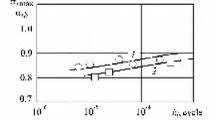Abstract
Four different topics for high-temperature components, namely the development of the assessment codes for the structural integrity of high-temperature components, the application of continuous damage mechanics and probabilistic damage mode on the life assessment of high-temperature components, the life extension for high-temperature components and a proposed strategy for remanufacturing of high-temperature components were discussed in this paper. These topics should provide some important insights for the design and re-design of high- temperature components.
Similar content being viewed by others
References
API Standard 530: 1988. Calculation of Heater-tube Thickness in Petroleum Refineries[M]. Washington: American Petroleum Institute, 1988.
ZHOU Chang-yu, TU Shan-dong. Studies on the damage and the service life calculation model of the furnace fire bars of a heating furnace[J]. Chemical Machine, 2001, 28(1): 26–29. (in Chinese)
TU Shan-dong. High Temperature Structure Integrity [M]. Beijing: Science Press, 2003. (in Chinese)
Nikbin K. A unified European approach to high temperature defect assessment code and its incorporation in a knowledge base system[J]. International Journal of Pressure Vessels and Piping, 2001, 78 (11–12): 929–935.
The American Society of Mechanical Engineers. ASME Boiler and Pressure Vessel Code, Case N-47 (29), Class 1 components in elevated temperature service, Section III, Division I[M]. New York: ASME, 1991.
AFCEN. RCC-MR. Materials Design and Construction Rules for Mechanical Components of FBR Nuclear Test Islands[M]. Paris: AFCEN, 1985.
Ewalds H L, Wanhill R J H. Fracture Mechanics [M]. London: Edward Amold, 1985.
Ewalds H L, Keienburg K H. A two criteria diagram for creep crack initiation[A]. Proceedings of the International Conference on Creep [C]. Tokyo: JSME, 1986. 173–176.
Ainsworth R A, Chell G G, Coleman M C, et al. CEGB assessment procedure for defects in plant operating in creep range[J]. Fatigue & Fracture of Engineering Materials & Structures, 1987, 10(2): 115–127.
Drubay B, Moulin D, Faidy C, et al. Defect assessment procedure: a French approach[J]. ASME Pressure Vessels and Piping Division, PVP, 1993, 266: 113–118.
British Standards BS 7910: 1999, Guide to methods to assessing the acceptability of flaws in fusion welded structures[S]. London, BSI, 1999.
Tu S T, Segle P. Creep damage and fracture of weldments at high temperature[J]. International Journal of Pressure Vessels and Piping, 2004, 81(2): 199–209.
Viswanathan R, Foulds J. Accelerated stress rupture testing for creep life prediction — its value and limitations[J]. ASME Journal of Pressure Vessel Technology, 1998, 120(2): 105–115.
Kachanov L M. Time of the rupture process under creep condition, Izvestiya Akademii Nauk SSSR[J]. Otdelenie Tekhnicheskihi Nauk, 1958, 8: 26–31. (in Russian)
Lemaitre J. A Course on Damage Mechanics[M]. Berlin: Springer Verlag, 1992.
Hall F R, Hayhurst D R. Continuum damage mechanics modelling of high temperature deformation and failure in a pipe weldment[A]. Proceedings of the Royal Society of London[C]. London: The Royal Society, 1991.
Hayhurst D R, Perrin I J. CDM analysis of creep rupture in weldments[A]. Proceedings of the 10th Conference on Engineering Mechanics [C]. New York: ASCE, 1995.
Tu S T, Sandstrom R. Numerical simulation of creep exhaustion of weldments and some design considerations[A]. Wilshire B, Evans R W. Proceedings of 5th international conference on creep and fracture of engineering materials and structures[C]. London: Institute of Materials, 1993. 695–704.
Tu S T, Gong J M, Ling X. Mechanical behavior of laboratory cross-weld specimen and its relation with the practical cases at elevated temperature[J]. Acta Metallurgica Sinica, 1999, 12(1): 82–88.
Segle P, Tu S T, Samuelson A L. Some issues in the life assessment of seam weld pipe subjected to creep [J]. International Journal of Pressure Vessels and Piping, 1996, 66(1–3): 199–222.
CHEN Jian-jun. Investigation of design criterion and welding repair principle of high temperature components using continuum damage mechanics based finite element method.[D]. Nanjing: College of Mechanical and Power Engineering, Nanjing University of Technology, 1999. (in Chinese)
CHEN Jian-jun, TU Shan-dong. Development of strain based criterion for high temperature design [A]. Structural Integrity and Materials Ageing, Proceedings of Fracture Mechanics Symposium [C]. Shanghai: ECUST, 2003.
Wei P R, Masser D, Liu H W, et al. Probabilistic considerations of creep crack growth[J]. Materials Science and Engineering, 1994, A189 (1–2): 69–76.
Harlow D G, Delph TJ. A computational probabilistic model for creep-damaging solids[J]. Computer & Structures, 1995, 54(1): 161–166.
Harlow D G, Delph T J. A probabilistic model for creep-fatigue failure[J]. Journal of Pressure Vessel Technology, 1997, 119(1): 45–51.
Mao H Y, Mahadevan S. Reliability analysis of creep-fatigue failure[J]. International Journal of Fatigue. 2000, 22(9): 789–797.
ZHOU Chang-yu, TU Shan-dong. Probabilistic creep damage and probabilistic damage diagram for high temperature components[J]. Journal of Mechanical Strength, 2002, 24(2): 243–245. (in Chinese)
Tu S T, Wu R, Sandstrom R. Design against creep failure for weldments in 0.5Cr0.5Mo0.25V pipe[J]. International Journal of Pressure Vessels and Piping, 1994, 58(3): 345–354.
GONG Jian-ming. Research on the structure integrity of weldments at elevated temperature[D]. Nanjing: College of Mechanical and Power Engineering, Nanjing University of Technology, 1999. (in Chinese)
Gong J M, Tu S T, Yoon K B. Damage assessment and maintenance strategy of hydrogne reformer furnace tubes[J]. Engineering Failure Analysis, 1999, 6 (3): 143–153.
Author information
Authors and Affiliations
Corresponding author
Rights and permissions
About this article
Cite this article
Wang, C., Shen, Sm. Structural integrity and life extension of high-temperature components. J Cent. South Univ. Technol. 12, 45–52 (2005). https://doi.org/10.1007/s11771-005-0009-x
Received:
Accepted:
Issue Date:
DOI: https://doi.org/10.1007/s11771-005-0009-x




